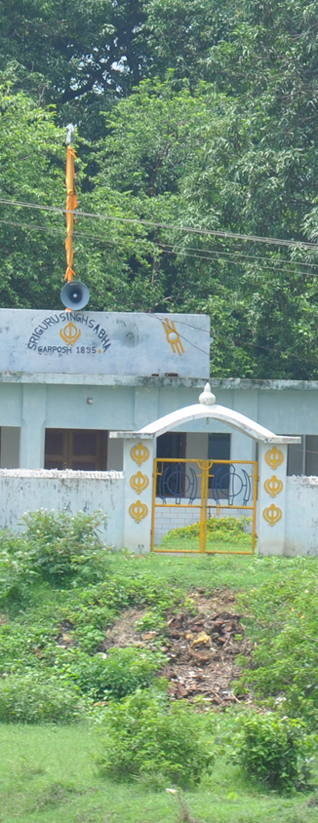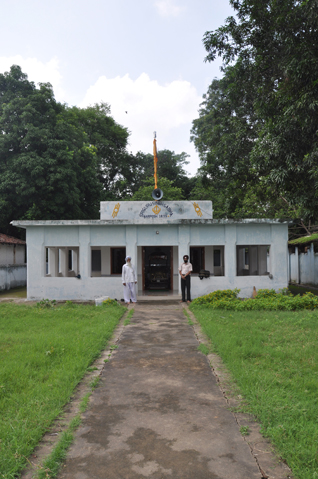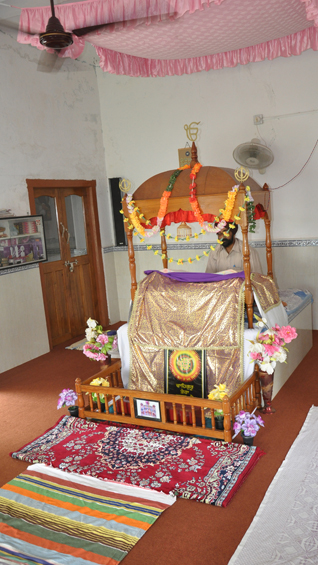Travel
The Saga of The Little Gurdwara of Garpos, Odisha
ANIL DHIR
I took the early morning passenger train out from Rourkela (in the state of Odisha -- formerly known as Orissa - India).
Garpos is a small nondescript village midway between Jharsuguda and Rourkela. The original old railway station, but for its new aluminum door, could have been a hundred years old.
I was told that the train would make a whistle-stop halt at the station and as it would be overcrowded I should shinny down as soon as it halted.
Jasbir Singh, the young teacher from the Khalsa High School at Rourkela, was waiting for me at the station. Just before the train made its way onto the small station, I positioned myself near the door. I saw the small gurdwara from the train, its Nishan Sahib clearly visible in the early morning haze.
There were a few adivasis (aboriginals) next to me who immediately folded their hands. One of the old heavily-tattooed women made a small child do the same. As I was camera ready, I clicked a few pictures of the gurdwara from the train.
The railways had made the foray into this tribal heartland more than a century ago. I got down at the station, dusted myself and made my way out among the teeming and milling crowd.
I espied the man who had paid obeisance to the gurdwara walking alongside towards the exit. I questioned him and he said that he and others have always done so, ever since they can remember. He told me that he could recall traveling on the line under the steam engines and elephants would be blocking the rail tracks.
I saw my host standing near the small entrance of the Station. With typical Punjabi hospitality I was welcomed and soon taken on the pillion of his motorcycle to his small home which adjoined the gurdwara.
Jasbir is a fourth generation Sikh of this small hamlet. It was his great grandfather, Basant Singh, who had come down to this place in 1890. Basant Singh had been a forest contractor who had worked for the railways in procuring wooden sleepers for the rail network that was spreading all over the country. He had successfully executed many works for them in Assam and Bengal and the Bengal Nagpur Railways authorities had given him a logging contract in the rich forests of Bamra State, with whose Raja the Railway authorities had come into an agreement.
Basant Singh spent a couple of years in Bamra and gained the appreciation of the Raja. Word of his honesty and diligence spread and the Raja of Sundargarh, Raghunath Sekhar Deo, called him and asked him to work in the forests of his fiefdom.
The Raja presented him with two horses and granted him land leases. The foundations for a systematic management of forests in the Gangpur ex-State were laid in the 1882-93 settlement of Mr. Hewitt, the then Divisional Commissioner of Chotanagpur. The Raja had opened his forests for sleeper operations and granted regular leases for a term of years on specified terms, but little or no provision was made for the proper management of forests by limiting the number of trees to be cut.
As a result, by 1907, the forests were recklessly exploited from all sides. The Raja of Gangpur had tried to garner much more profit from the sleeper operations. In 1891-92, the Raja got an offer for sleepers at over Rs. 5 per piece, but was intending to keep the sleepers in the depot so as to sell them when the line was to be made from Cuttack to Sambalpur.
It is known that the Raja cancelled all the sleeper leases by 1901 so as to appropriate maximum profit by directly dealing in the business. In fact, a sleeper department was organised for this purpose and sleepers were extracted indiscriminately.
Basant Singh was appointed to manage the entire business.
A devout Sikh, Basant Singh was an honest and diligent man. He strongly believed in the power and strength of the Almighty and led an austere life. Not for him the vices of the time, he was a teetotaler and even a vegetarian. He used to always carry the holy Guru Granth Sahib with him, and adhered to the teachings of the Sikh Gurus.
He soon gained the appreciation of both the Rajas of Bamra and Sundargarh and was given logging rights and forest produce contracts by them.
The railway had just reached the area, and as Garpos happened to be right midway, he built a small house near the railway tracks. Basant Singh was enamoured by the natural beauty of the place.
Garpos was originally named Gondpos, as it was inhabited by the Gond tribesmen who had been settled here by the Raja.
Basant Singh’s was the first house in this small hamlet. Others followed. The area was within a thick jungle and often tigers and other wild animals would stray in.
As his business was flourishing, Basant Singh encouraged a few more Sikh families to come and settle there. He, along with his brother Bhagat Singh, helped them set up businesses and get contracts from the railways and the Rajas.
It was in 1895 that Basant Singh set up a small gurdwara near the railway station. It was a thatched one-room affair and the Guru Granth Sahib was consecrated there. This was the only gurdwara within miles around and would draw a flock of Sikhs from near and afar. Sikhs from Sambalpur, Raipur, Jharsuguda, Rajgangpur and other places would gather here for gurupurabs.
They would come and camp in Garpos for a couple of days. Basant Singh was only too happy to host them.
Bhagat Singh, his younger brother, too was a devout Sikh and he would perform the daily protocol in the gurdwara.
It was because of Basant Singh and his brother that Garpos gained fame as a market for forest produce. Traders would come here to get lac, jhoona, Kendu leaves, charcoal, minor forest produce and wooden sleepers.
Basant Singh met an untimely death due to small pox at the age of 46 years in 1916. His brother took over the reins of the business and kept it going. All along the little gurdwara flourished as the beacon for the Sikh faith in this little corner of Odisha.
The post First World War years saw an increased demand from railways and wooden sleepers from the forests of Gangpur were sent all over the world. Bhagat Singh would send the sleepers to Calcutta Port from where they were shipped all over. They employed a huge work force, including many elephants.
Bhagat Singh died in 1951.
Throughout his life, he maintained the small gurdwara and kept the Nishan Sahib flying high. Such was his devotion that locals, the Marwari and Gujarat businessmen, Bengali officers, even the tribals venerated the gurdwara and would come here to pray. The gurdwara would organise free langars and feed hundreds of people.
Like his brother Basant Singh, Bhagat too was a kind hearted man and would help the local people during times of need. There are many stories of the large heartedness of the small Sikh community of Garpos which is still alive in the memories of the small place.
In 1946, it was decided that the gurdwara would be done up on a bigger scale and the community pooled in for the funds. There were plans to make a pucca building with a separate place for the kitchen and the granthi. Work started but was stopped after the death of Bhagat Singh in 1951.
The Sikhs of Garpos, who were mostly in the forest trade, faced bad times. The abolition of the princely states by the Independent government hit their business and royal patronage was no more coming.
Quite a few families shifted back to Punjab but the descendants of Basant Singh stayed put. They faced difficult times but learnt to manage frugally. What hurt them the most was their unfinished gurdwara.
In 1953, a Sikh devout parcharak, Sant Kalyan Das passed by Garpos. So enamoured was he with the small gurdwara and the Sikhs there, that he stayed back for a few months. Kalyan Das was an eminent scholar who had written many books on Guru Nanak. He was impressed by the devotion and faith of the Sikh sangat there and after he left the place, he promised that he would see that the gurdwara was completed.
Sardar Labh Singh of Dehradun who had come to Sundargarh for executing some government contracts made a large contribution and along with the donations from the locals the new gurdwara was completed in 1962.
A huge gathering of Sikhs from nearby places gathered here for the celebrations. The new little gurdwara was now the centre of attraction in this little place and people flocked there in hundreds. There was a verandah all around and the red-tiled roof with the Nishan Sahib stood out distinctly in the place.
It was from this time, I presume, that all train travellers bowed and folded their hands when the train passed Garpos, an example of which I had seen in the morning.
From 1964, the Orissa Forest Corporation took over the entire forests of the State and private contractors were no more players. Many of the Sikhs of Garpos left fom nearby places like Rourkela and Sambalpur.
With the building of the Rourkela Steel Plant and the Hirakund Dam there were many opportunities for them to go to greener pastures. But the family of Basant Singh remained behind.
There were many emotional strings that kept them back. Primarily, their little gurdwara could not be abandoned. By the 1970’s, only the direct descendants of Basant Singh’s family remained behind.
Today there are only 18 Sikh families comprising of 50 members in Garpos. Six of them stay in homes that adjoin the gurdwara.
In the course of time the tiles and the wooden planks that supported them got damaged. Once again the small community pooled together their meager resources and with the help of locals started the work of making a concrete structure for the gurdwara.
The Local MLA’s heard of the challenges they faced and contributed from their funds.
The new gurdwara building I saw had been completed just a couple of years ago, but the charm and nostalgia of yesteryear was still prevalent.
Jasbir took me to the gurdwara. His father Mahijit Singh is the oldest patriarch of the community and devotes all his time for the upkeep of the gurdwara. Jasbir himself gets up early each morning, conducts the the parkash seva and then leaves for Rourkela to teach at the Khalsa School.
The people of Garpos wake up to the early recital of gurbani which they hear on the small loudspeaker that has been put up on the roof the gurdwara.
Jasbir’s wife too manages the upkeep. She helps in keeping the premises clean. The manji and palki had been handmade by Jasbir himself. The palki was beautifully crafted. The rumalla and the chanani had been stitched by his wife. The simplicity and beauty of these works, which glittered in the early morning sunshine that shone in from the opened doors, was spell binding.
The adjoining little sach khand, the room where the Guru Granth Sahib was put to rest in the night was quaintly small, in sync with the little gurdwara.
Jasbir showed me the stack of old gutkas that were kept there. These were the small hymn books which contain chosen banis from the Sikh scriptures. The much frayed Guru Granth Sahib (biradh saroop) which had been originally there for ages had been taken away just a couple of years ago and replaced by a new one. This is called the ‘agan bhent’ seva (consigning to flames with due reverence) whereby old and frayed editions of Guru Granth Sahib and other religious booklets are replaced with new ones.
There was an atmosphere of serenity and silence in the gurdwara.
Jasbir took his place before the Guru Granth Sahib and soon the melodious chanting of gurbani filled me with sanctity, piety and a deep sense of inner peace. Sitting cross legged in the gurdwara, with only Jasbir and his father for company, I could gather the true essence of the Mool Mantar.
The Mool Mantar is said to be the first composition uttered by Guru Nanak upon enlightenment at the young age of thirty.
Being the basis of Sikhism, it encapsulates the entire theology of the religion. Though it is the most widely known part of the Sikh scripture, it has always posed a challenge to translators. In spite of being a brief composition, it conveys the religious, social, political, logical, martial and eternal implication for human existence.
The Mool Mantra is a fate killer. It removes the concept of fate and changes the destiny to complete prosperity. This bani has a powerful vibration of upliftment that teaches purity, prosperity and grace. The chanting of the Mool Mantar can render the belief that fate can be dissolved and destiny rewritten.
I could have stayed back at the little gurdwara for the day, but Jasbir had to go to Rourkela. We went over to his house for a late breakfast. A few members of the extended family came to meet me and Jasbir proudly introduced me as someone who had heard about their gurdwara and had come to see it.
They had tales to relates, but Jasbir asked me to hurry up as the train was due.
I went back to the gurdwara once again and sat down on the verandah. There was a strange sense of connect which I cannot explain. The others left me alone, sensing that I wanted solitude. Jasbir told me that I could come when I heard the announcement of the train’s arrival from the railway station’s loudspeaker.
I sat there for half an hour. The birds chirped in the nearby trees.
Sikhism focuses on unity with God. It teaches to be one with God through meditation and simple, ethical and moral living. Qualities like honesty, compassion, generosity, patience, humility, etc. can be built up only by diligence and perseverance.
In the short time that I spent in Garpos, I found all these qualities in the small community there.
According to Sikh religious thought, God is both transcendent and immanent. God is beyond the empirical universe; he cannot be sensed or measured. God dwells in everyone’s heart all the time. He is the ocean in which we live out our lives.
For me, that morning, I had found God in the little gurdwara tucked away in a small corner of rural Odisha.
I boarded the train along with Jasbir. As it pulled out of the little station, I felt a lump in my throat. I was leaving a little bit of myself back here.
I had taken umpteen photos of the gurdwara, but in the end I found that the one I had randomly clicked from the train while coming in was the best [the image on the top of this page.]
If you ever travel on the Sambalpur - Rourkela Line, look out for the Garpos Gurdwara. If the train stops there, do get down and spend a couple of hours.
The Sikhs of Garpos would be only too happy.
[The author is an independent researcher based in Odisha, India. He has done his Master's in English, History and Public Administration. His interests include flying, film making, collecting old books and manuscripts, Indian temple art and architecture, green issues, and traveling second class by Indian Railways. He has directed and produced an award winning film titled “The Last Post”. He has written three books and is now completing a book on the Sikhs of Odisha.]
August 12, 2014
Conversation about this article
1: Sangat Singh (Kuala Lumpur, Malaysia), August 12, 2014, 9:11 PM.
When I saw this post my immediate first reaction was: "Oh God! Sikhs have made inroads even in unheard towns and countries." The mystery cleared when I realized Orissa had now been corrupted to Odisha. Anil Dhir has done an excellent job. Anil ji, please also visit other unknown, unheralded and hidden gurdwaras and report on them as you've done on this one so lovingly and respectfully. "Jithai jaa-ay bahai mayraa satguru so thaan suhavaa raam raajay" [GGS:450.17] - "Wherever my True Guru goes and sits, that place become beautiful and exhalted." No SPGC or gold domes were required. No one outside the nondescript hamlet had heard about it in over a hundred years. "Kaho Naanak sab tayree vadya-ee ko-ee naa-o na jaanai mayraa" [GGS:383.12] - "Says Nanak, this is all Your Greatness, no one even knows my name." Bless you, Anil.
2: Jasbeer Singh (New Delhi, India), August 13, 2014, 1:23 PM.
Thank you for sharing! After reading this article, I can say we can alone better manage affairs of our gurdwaras, if we really want to do that, we don't need these management committees at all.





